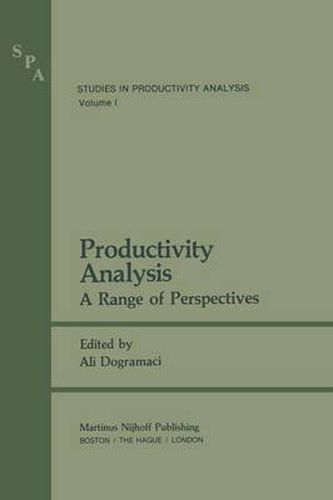Readings Newsletter
Become a Readings Member to make your shopping experience even easier.
Sign in or sign up for free!
You’re not far away from qualifying for FREE standard shipping within Australia
You’ve qualified for FREE standard shipping within Australia
The cart is loading…






This title is printed to order. This book may have been self-published. If so, we cannot guarantee the quality of the content. In the main most books will have gone through the editing process however some may not. We therefore suggest that you be aware of this before ordering this book. If in doubt check either the author or publisher’s details as we are unable to accept any returns unless they are faulty. Please contact us if you have any questions.
There is a wide variety of perspectives for productivity analysis. The back grounds of different researchers and practitioners who work on this topic include such fields as economics, business administration, and industrial engineering, among others. Within each such field, there are different schools of thought on the theory and application of productivity analysis. Often it is not difficult to observe a lack of communication among the advocates of these separate schools. The purpose of this book is to present in a single volume samples of alternative approaches to productivity analy sis. This may be considered as a first step toward a better communication among practitioners and researchers in the fields of management, industrial engineering, and economics. The focus of the book is on the United States, where the productivity growth problem has been acute for some time. The book begins with a brief overview chapter that covers some of the issues involved in productivity analysis and a sample of methodological ap proaches presently in use. After this introduction, we move to Chapter 2 where Solomon Fabricant presents the issues related to measurement and analysis at the macroeconomic level. In Chapter 3, C. Lowell Harriss discusses concepts that he considers es sential for productivity growth: capital formation, technological progress, and freedom.
$9.00 standard shipping within Australia
FREE standard shipping within Australia for orders over $100.00
Express & International shipping calculated at checkout
This title is printed to order. This book may have been self-published. If so, we cannot guarantee the quality of the content. In the main most books will have gone through the editing process however some may not. We therefore suggest that you be aware of this before ordering this book. If in doubt check either the author or publisher’s details as we are unable to accept any returns unless they are faulty. Please contact us if you have any questions.
There is a wide variety of perspectives for productivity analysis. The back grounds of different researchers and practitioners who work on this topic include such fields as economics, business administration, and industrial engineering, among others. Within each such field, there are different schools of thought on the theory and application of productivity analysis. Often it is not difficult to observe a lack of communication among the advocates of these separate schools. The purpose of this book is to present in a single volume samples of alternative approaches to productivity analy sis. This may be considered as a first step toward a better communication among practitioners and researchers in the fields of management, industrial engineering, and economics. The focus of the book is on the United States, where the productivity growth problem has been acute for some time. The book begins with a brief overview chapter that covers some of the issues involved in productivity analysis and a sample of methodological ap proaches presently in use. After this introduction, we move to Chapter 2 where Solomon Fabricant presents the issues related to measurement and analysis at the macroeconomic level. In Chapter 3, C. Lowell Harriss discusses concepts that he considers es sential for productivity growth: capital formation, technological progress, and freedom.